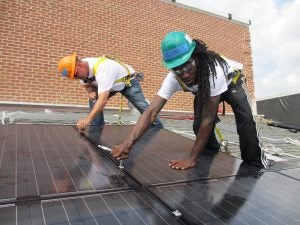Texas Leaders Can Use Clean Energy to Increase Investments and Create Jobs. Here’s How.
 It’s that time again. Texas leaders are meeting in Austin for the 85th Legislative Session and the next five months will be an interesting wrestling match over human rights, voting rights, bathroom rights, and local rights.
It’s that time again. Texas leaders are meeting in Austin for the 85th Legislative Session and the next five months will be an interesting wrestling match over human rights, voting rights, bathroom rights, and local rights.
But what about our economic rights? A new report Environmental Defense Fund (EDF) issued to the Texas Legislature, Texas’ Clean Energy Economy: Prioritizing Jobs, Investments, and Growth, shows the Lone Star State’s evolving electricity landscape has created enormous economic growth and jobs. The report explores the policies put in place years ago that has allowed Texas’ power market to become cleaner and more affordable, and it outlines the state’s impressive job growth in energy efficiency, wind, and solar power.
The report urges our leaders to develop and implement a bold, comprehensive Texas energy plan to create well-paid jobs, drive innovation and investment, make us more energy independent, and protect our water supplies, while improving the health of Texans and the environment.
Transition underway
The electricity sector in Texas and across the U.S. is experiencing dramatic change. In the past few years, less electricity has come from coal because of cheaper natural gas and renewables. Unprecedented energy innovation and a robust, competitive market are rapidly transitioning Texas to a clean energy economy.
[Tweet “Texas Leaders Can Use Clean Energy to Increase Investments and Create Jobs. Here’s How.”]
In fact, national economic consulting firm The Brattle Group recently concluded 85 percent of Texas’ electricity in 2035 will come from natural gas and renewables. Moreover, coal’s share will fall to 6 percent if gas prices remain below $4 per MMBTU and if solar prices continue to decline as forecasted.
Additionally, as the state’s wind industry continues to thrive, solar is poised for liftoff. The U.S. Department of Energy Wind Vision Scenario projects that Texas could produce enough wind energy by 2030 to power the equivalent of 15.4 million homes. And the state’s primary grid operator, the Electric Reliability Council of Texas (ERCOT), forecasts an approximately 70-fold increase in solar energy capacity from 2015 to 2030 under business as usual conditions.
Clean energy rewards
Fortunately, the Lone Star State more than any other is uniquely positioned to benefit from the global transition to cleaner energy: We produce more natural gas and wind power, and we have more potential for solar power, energy efficiency, and demand response (an innovative mechanism that rewards customers and businesses for saving energy).
Harnessing the full potential of our clean resources will lead Texas to billions in savings in electricity, water, and healthcare. Here’s a closer look at the benefits we can expect:
State leaders need to leverage Texas’ outstanding clean energy assets to achieve our full potential as the nation’s economic powerhouse.
- Jobs: Wind and solar power generation now employs more than four times as many Texans as fossil-fuel electricity. In addition, nearly 150,000 Texans work in energy efficiency-related jobs.
- Energy efficiency savings: Legislatively-approved building codes and utility efficiency programs are already on track to save Texans almost $5 billion.
- Lower electricity prices: Today’s prices in ERCOT are less than a third of 2008’s peak prices, and are even lower than when retail electric competition began in 2002, even without accounting for the impact of inflation. Meanwhile, coal’s share of the state’s generation mix has been shrinking and wind’s share has been steadily increasing, growing from one percent in 2002 to providing nearly 13 percent of all in-state electricity production for the 12-month period ending October 2016.
- Water savings: If all coal-fired electric generation facilities were replaced with more competitive natural gas and renewables over the next 20 years, Texas water planners could completely eliminate the need for projected additional water supplies for the power sector, which the Texas Water Development Board estimated would have a 2012 price of $2.3 billion. In addition to the financial savings, this means more water could be allocated to Texas homes, businesses, industry, and agriculture, rather than to coal-powered plants.
- Healthier Texans: By lowering coal power plant emissions by approximately 30 percent, which is achievable under business as usual conditions, it is estimated that 2,300 Texas lives could be saved, along with $20 billion in associated costs. Plus, 790 hospitalizations and 140 heart attacks could be avoided.
As we consider our economic rights this Session, we should remember that Texas has a global competitive advantage because it’s a big state with ample wind, solar, and natural gas resources, and we have the potential to save considerable money through energy efficiency. Moreover, 85 percent of Texas voters support increasing clean power.
State leaders need to leverage Texas’ outstanding clean energy assets to achieve our full potential as the nation’s economic powerhouse – with an electricity system that’s cleaner and healthier, as well as less water-intensive and wasteful. EDF’s new report shows that by developing and implementing a bold, comprehensive Texas energy plan, legislators can grow the state’s economy, create jobs, attract investment, and save billions of dollars.










